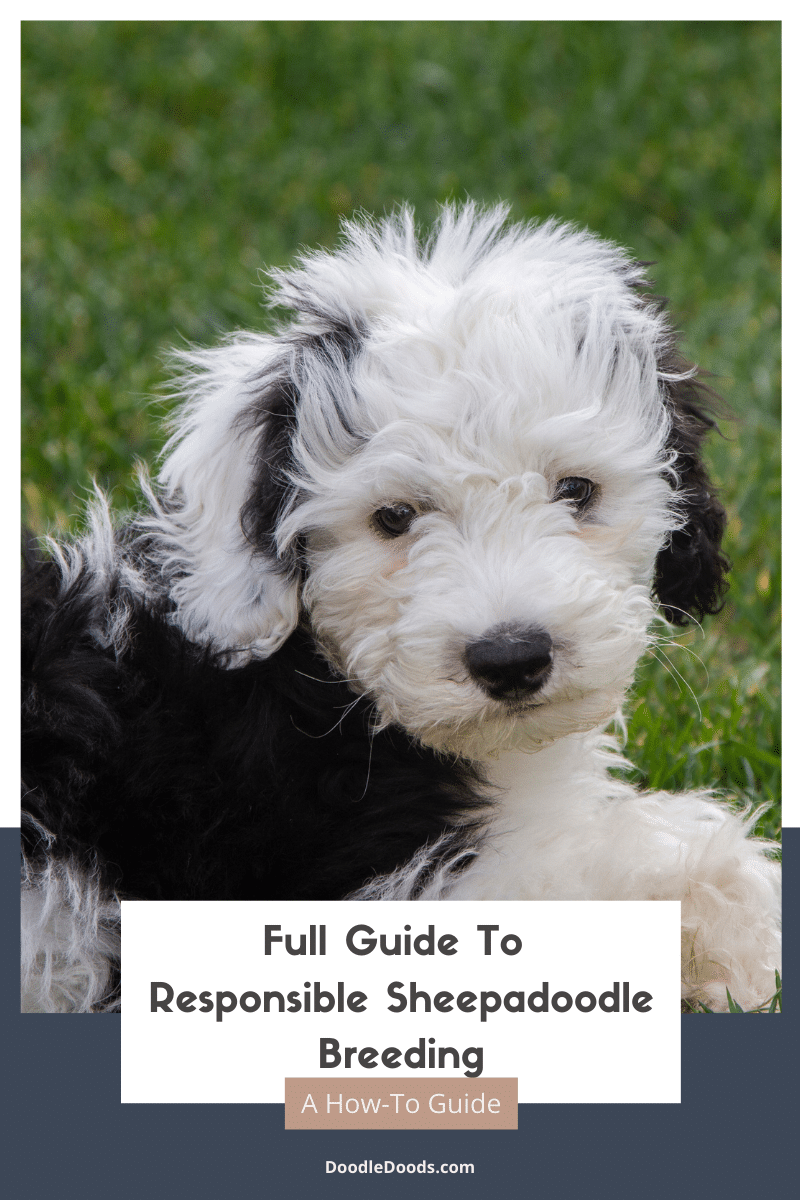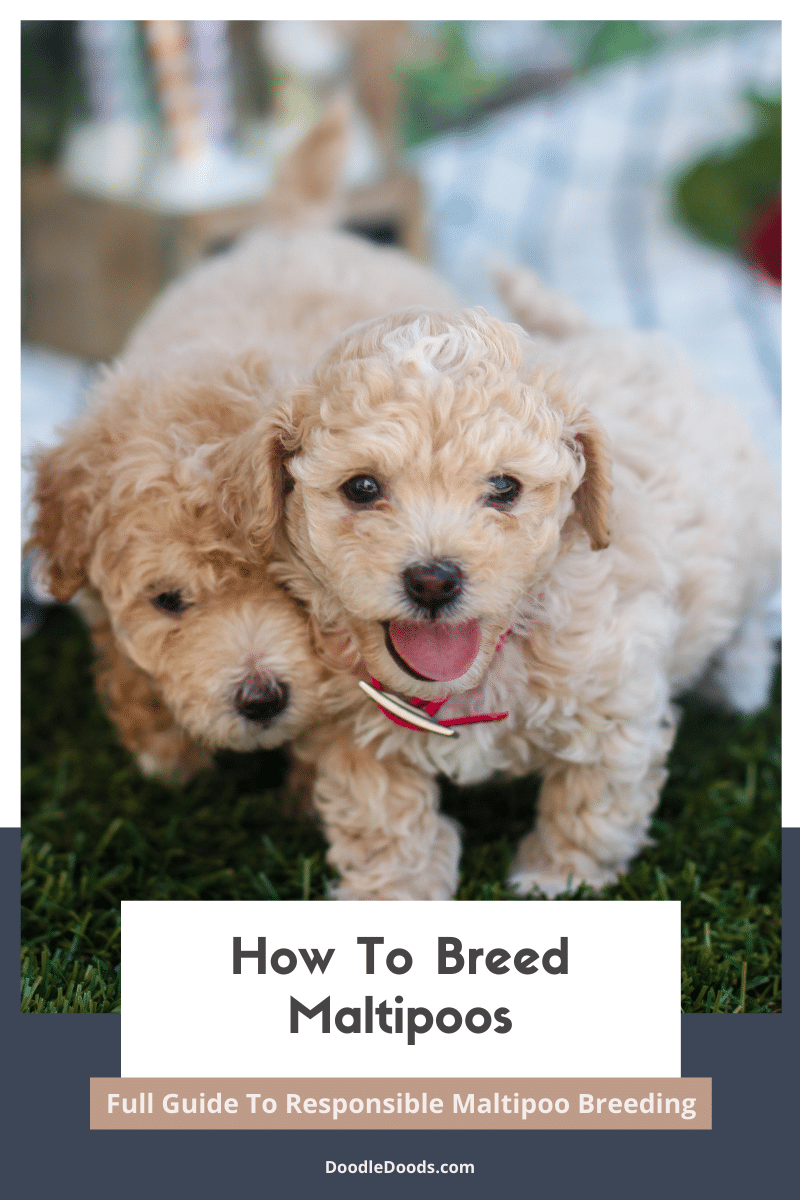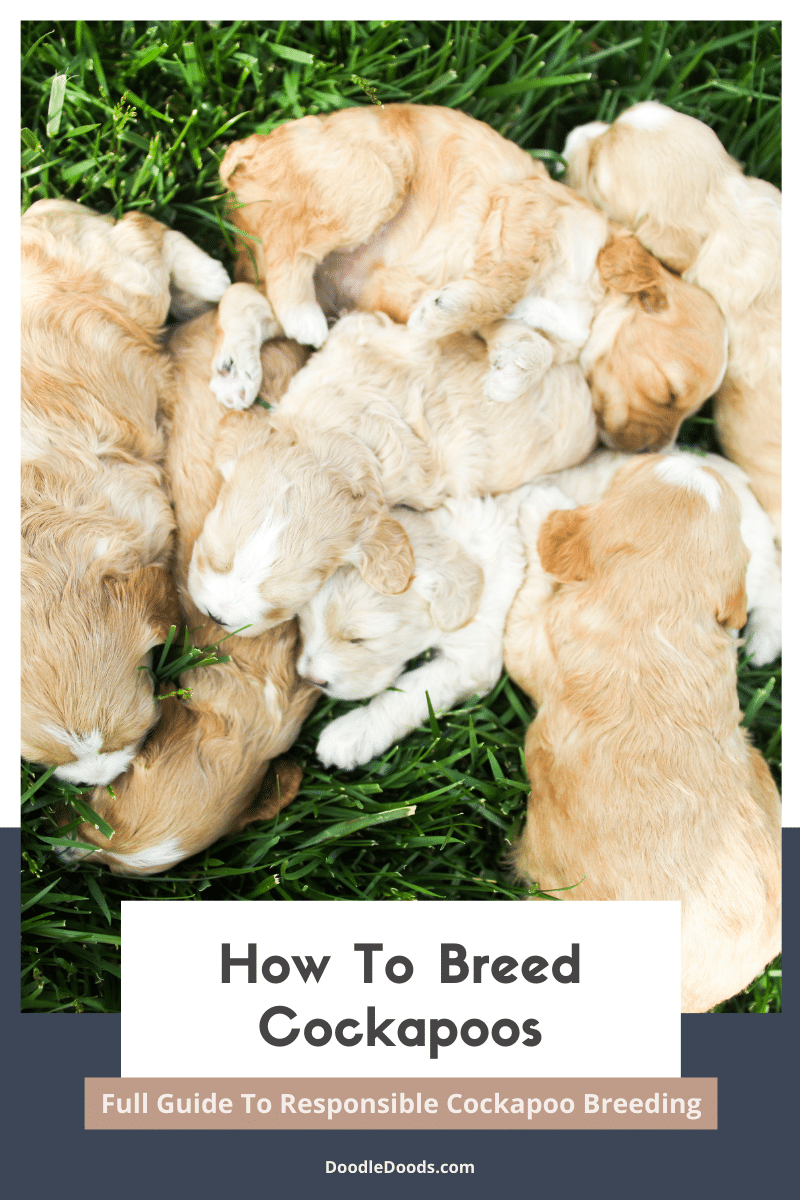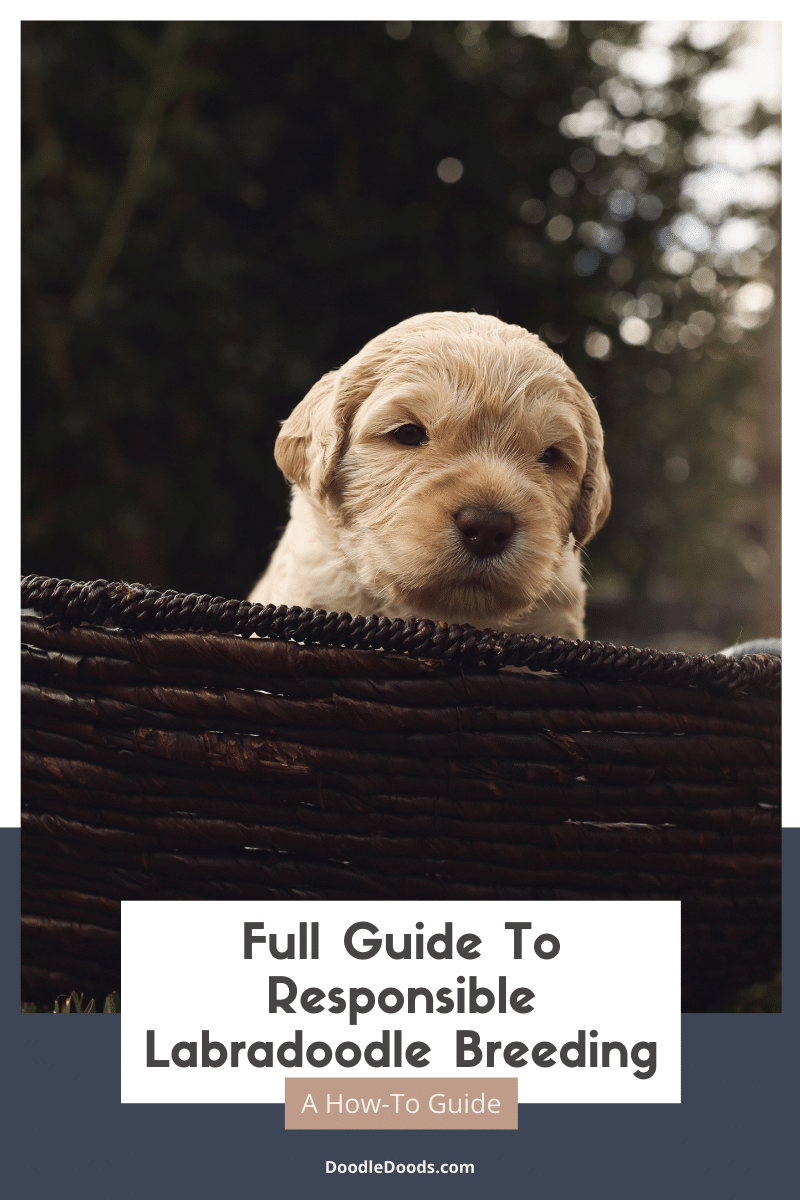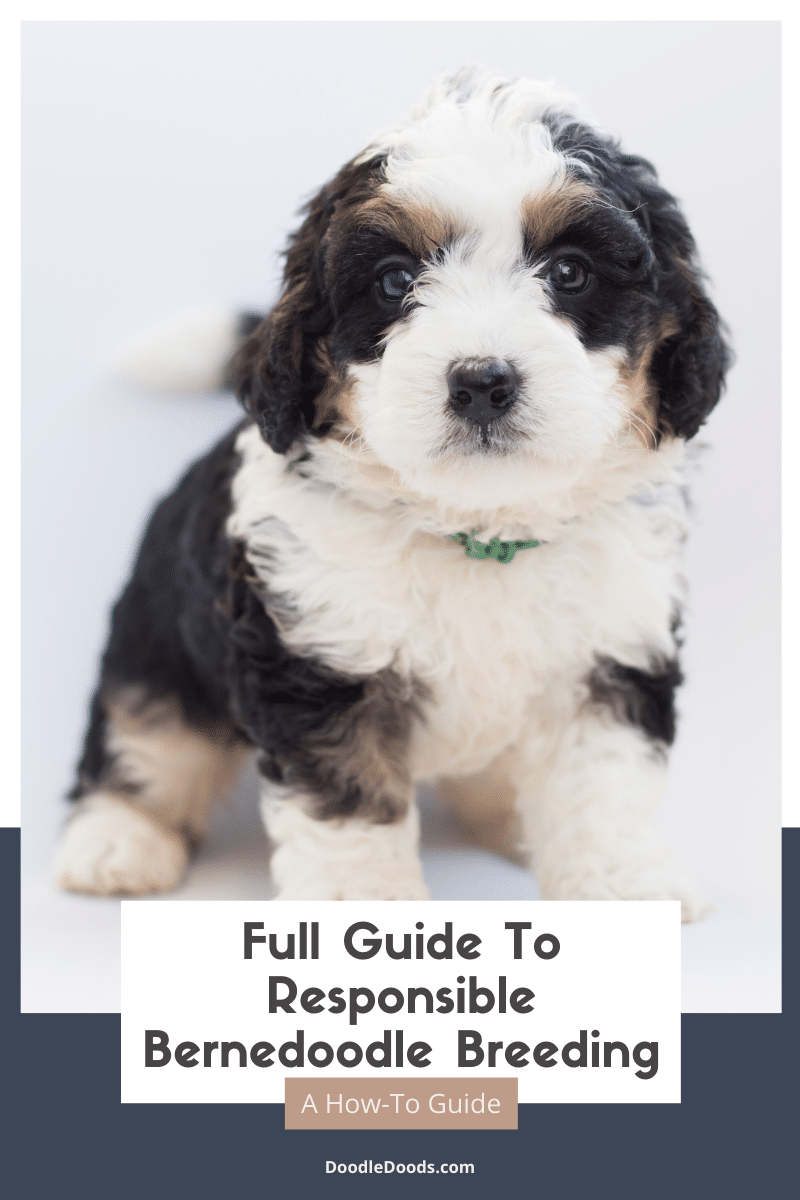If you’re thinking about getting into Sheepadoodle breeding, then we can absolutely guarantee that it’s going to be a wonderful, rewarding experience. However, it’s not just fun and games breeding new puppies. In fact, it requires a ton of research and preparation. So, if you’d like to venture into breeding Sheepadoodles, it’s crucial that you do so responsibly, following ethical breeding guidelines. If you’re ready to take on this responsibility, then keep on reading.
Table of Contents
- Full Guide To Responsible Sheepadoodle Breeding: Intro
- Sheepadoodle Breeding How-To
- What Is The Best Age To Breed A Sheepadoodle?
- How Much Does It Cost To Breed A Sheepadoodle?
- Full Guide To Responsible Sheepadoodle Breeding: Frequently Asked Questions
- Full Guide To Responsible Sheepadoodle Breeding: Final Thoughts
Full Guide To Responsible Sheepadoodle Breeding: Intro
Sheepadoodles are an amazing hybrid cross between the Old English Sheepdog and Poodle. These large Doods deserve their Gentle Giant name just like their purebred Sheepdog parents. They’re insanely cute, loving, playful, yet calm. They love to do all sorts of fun outdoorsy activities with their human parents, making them excellent family pets and therapy dogs. And thanks to their high levels of intelligence, Sheepadoodles are rather easy to train.
What’s even better about the Sheepadoodle is that they greatly benefit from the Poodle genes. In contrast to their Sheepdog parents, Sheepadoodles are low-shedding and allergy-friendly pups, which means that these dogs are suitable even for people with allergies.
So, if you’re thinking about bringing a litter, few, or more of these Doods into this world, you’d probably like to know how to breed Sheepadoodles. That’s exactly what we’re going to discuss in this guide.
Sheepadoodle Breeding How-To
We all know the feeling that you get when looking at your canine pal, thinking what an amazing thing it would be for them to have their very own babies. Not to mention, what a joyful thing it would be to help other people adopt puppies just as cute as yours. And that’s exactly how many people start out as breeders. However, there’s more to it than just having your pup mate with another dog.
If you’re seriously considering breeding Sheepadoodles, understanding the basics of responsible breeding is vital. To be fair, we recommend you do a ton of research beforehand and educate yourself extensively before getting started. Above all, your goal should be to breed the healthiest, happiest puppies possible, while also taking good care of your breeding parents. To help you get started, we’ve listed below some of the most important things to consider.
Decide What Type Of Sheepadoodle You Want To Breed
Before you get started, you should think about which types of Sheepadoodles you’d like to breed. Maybe you’d like to breed Standard Sheepadoodles? Or are you thinking about smaller Mini or Toy Sheepadoodles, instead? Or maybe you’d like to produce all of those sizes? That’s something you should think about well in advance.
Here’s a quick overview of the possible Sheepadoodle sizes that you can consider:
| Toy Sheepadoodle | Mini/Medium Sheepadoodle | Standard Sheepadoodle | |
| Weight | 10-25 pounds | 25-55 pounds | 55–85 pounds |
| Height* | 15 inches or less | 15-22 inches | 22-27 inches |
| Age at Full-Grown | 7.5-11 Months | 11-13 months | 12.5-16 Months |
*A dog’s height is measured from their withers, which is the highest part of their shoulder blades.
Since the Poodle comes in three sizes – Standard, Miniature, and Toy – then there’s also the possibility to produce different sized Sheepadoodles. As the size of the Poodle used in the mix can greatly affect the size of the puppies, there’s quite a lot of room for variation.
For instance, if you’d like to breed the largest Standard Sheepadoodles, you’ll want to use a Standard Poodle in the mix. But if your goal is to breed smaller Mini Sheepadoodles, you should use a Miniature Poodle in the mix. Likewise, if you’d like to breed the smallest Toy Sheepadoodles, using a Toy Poodle is necessary.
Keep in mind, however, that you should not mate two dogs that are very different in size. As Sheepdogs and Standard Poodles are both on the larger side, you can produce these puppies as first-generation or later generations. In contrast, if you’re thinking about breeding smaller Toy or Miniature Sheepadoodles, you may want to produce them as backcross generations instead. This will also provide you with more control over the puppies size, but more on that in a moment.
PS! When breeding two different sized dogs, the smaller should always be the father (sire) to prevent any physical harm to the mother (dam).
Sheepadoodle Breeding Chart: All About Generations
When it comes to breeding Sheepadoodles, there’s also the matter of generations. You might’ve heard that there are F1 Sheepadoodles, F1b, F2, and Multigen Sheepadoodles. To help you gain a better understanding of this complex topic, have a look at the Sheepadoodle breeding chart below:
| 1st Parent | 2nd Parent | % Old English Sheepdog* | % Poodle* | |
| F1 Sheepadoodle (first-generation) | Old English Sheepdog | Poodle | 50% | 50% |
| F1B Sheepadoodle (first-generation backcross) | F1 Sheepadoodle | Poodle | 25% | 75% |
| F1BB Sheepadoodle (first-generation backcross backcross) | F1B Sheepadoodle | Poodle | 12.5% | 87.5% |
| F2 Sheepadoodle (second-generation) | F1 Sheepadoodle | F1 Sheepadoodle | 50% | 50% |
| F2B Sheepadoodle (second-generation backcross) | F1 Sheepadoodle | F1B Sheepadoodle | 37.5% | 62.5% |
| F2B Sheepadoodle (alternate cross) | F2 Sheepadoodle | Poodle | 25% | 75% |
| F3 / Multigen Sheepadoodle | F1B Sheepadoodle or higher | F1B Sheepadoodle or higher | Varies | Varies |
*These are generic calculations only – genetics are rarely mathematically accurate.

Essentially, Sheepadoodle generations tell us how a litter of puppies was bred, and how much of their genetic makeup roughly consists of either of the parental breeds. Of course, you have to keep in mind that these are just rough estimates, and the actual outcome will be determined by each puppy’s unique genetic makeup.
Nonetheless, the great thing about generations is that we can achieve more control over the puppies’ size, coat type, color, potential for shedding, and other traits. For instance, F1 Sheepadoodles may be rather tricky to predict, whereas with F1b Sheepadoodles we can achieve more Poodle-like traits and characteristics.
Sheepadoodle Breeding Non-Negotiable: Health & Genetic Testing
Now we’re getting into the serious stuff! If you’re really serious about establishing your Sheepadoodle breeding program, it’s absolutely vital that you choose the healthiest parents possible. And no, it doesn’t matter if your vet says that all seems good based on the usual health checkup. You actually have to have your breeding dogs extensively health and DNA tested for various genetic conditions before breeding any litters. Although a costly extra step, this is non-negotiable when it comes to responsible breeding.
Some of the most common health issues in Sheepadoodles include joint problems, such as hip and elbow dysplasia, and patellar luxation. They’re also at risk of certain heart conditions, Addison’s disease, and Cushing’s disease. In addition to that, eye diseases like progressive retinal atrophy (PRA), cataracts, and entropion are also common in Sheepadoodles.
All of these diseases, and many others, can be prevented to an extent with proper health screening through extensive genetic testing. You should look into genetic tests that are accepted by the OFA (the Orthopedic Foundation of Animals), such as Embark testing.
Coat Testing
Did you know that you can also have your parent dogs tested for their coat genetics? This lets you choose the parents based on certain genetics to better predict how the puppies will turn out.
As Sheepadoodles were first created to achieve a low-shedding and hypoallergenic combination of the Old English Sheepdog and Poodle, it’s highly likely that this is what you (and other breeders) are also striving for. However, as with any hybrid breed, the outcome isn’t always as straightforward. And that’s where coat genetics come in handy.
Likewise, if you’re keen on having your puppies with specific coat colors, that can also be determined with the help of genetics. For instance, if you’d like to produce the highly coveted merle coat, one of the parents has to carry the merle gene. But! Keep in mind that responsible breeders never mate two dogs carrying the merle gene, as this comes with an increased risk of blindness and deafness.
Consider The Parents’ Personality & Temperament
Another thing to consider before starting your Sheepadoodle breeding program is the personality and temperament of your breeding dogs. In fact, reputable breeders usually choose their parents not just based on their genetics, but also their personality traits.
Fortunately, like other Doodles, Sheepadoodles are generally bred to be loving, social, and gentle in their mannerisms. So, it’s very likely that your own Sheepadoodle already possesses those traits, and they’ve strengthened having been passed down for generations already.
But, that’s not to say that each puppy in the litter will have the exact same personality and behave exactly the same. As with any other living being, each puppy will have their own unique set of temperament traits. Of course, the puppies’ upbringing will also play a huge role here, as those early associations and interactions will leave a mark on them. But more on this topic later.
Team Up With A Licensed Veterinarian
Needless to say, if your goal is to start breeding Sheepadoodles, you have to work closely with a licensed, experienced veterinarian. Your trusted veterinarian will be your one point contact for any and all concerns, starting from choosing the healthiest parents for the program to prenatal care, finishing with the whelping process and administering first puppy shots.
Above all, you want to make sure that both your puppies and puppy parents are healthy, safe, and comfortable throughout all stages of breeding. That’s why it’s vital to work closely with a trusted veterinarian that can help you keep track of their health and wellbeing through all of those stages of breeding new litters.
Understand The Importance Of Early Socialization, Training, & Other Forms Of Enrichment Methods
Bringing new puppies into this world isn’t just about health and genetics, either. You also have to take into account all the work that happens once the puppies are born. If you’re striving to become a responsible Sheepadoodle breeder, you have to start socializing your puppies from an early age, so that they learn how to properly behave and interact with people of all ages, other dogs, and why not even other animals.
That being said, you also have to put great emphasis on various enrichment methods and household desensitization. Safely introducing the puppies to various sights, sounds, and experiences is an excellent way for them to become accustomed to all sorts of noises and experiences that are normal in any household. These include regular grooming, vacuuming, hearing and seeing the TV, going on car rides, and inspecting various surfaces and textures.
In addition to that, you should also provide plenty of mental and physical stimulation for the pups. For instance, puzzle games, interactive toys, and chew toys all provide that much-needed stimulation for puppies, as well as daily walks and exercise. By the way, enrichment methods also go a long way in helping to prevent destructive behaviors stemming from boredom.
Moreover, responsible breeders generally start their puppies on potty training, crate training, and obedience training. Of course, no puppy will ever be fully trained by the time they go home at 8 weeks old. However, getting them started early on will surely set them up for success.
Understandably, there’s a lot to learn about all of these socialization and training techniques. That’s why many reputable breeders opt to find help from renowned programs, such as Puppy Culture, Badass Breeder’s Guide, or Avidog. If you’d like to go one step further, you can also consider the Early Neurological Stimulation (ENS) that’s thought to improve the puppies’ intolerance to stress, disease, and improve their heart health. Of course, this is also an excellent way for the puppies to get used to regular body handling.
Stock Up On Breeding Supplies
So, once you’ve decided to give Sheepadoodle breeding a go, it’s also important that you have all the necessary supplies for your parent dogs and puppies already purchased and ready to go.
Also, carefully consider where you’re going to whelp and raise your puppies. For instance, reputable breeders generally raise their puppies indoors in their own homes. This way, you can always keep an eye on the pups, they’ll get a great head start in socialization, and you can get them adjusted to all sorts of household sounds and experiences.
In terms of breeding supplies, here are some of the most important items that you should stock up on:
- Dog beds
- Food and water bowls
- Dog food and puppy food
- Puppy treats
- Dog crates
- Collars, leashes, and harnesses
- Grooming tools
- Toys
- First aid supplies
- Potty training aids
- Blankets
- Whelping boxes
- Whelping pads
- Disposable gloves
- Sanitizers
- Heating pads and cooling pads
- Bulb syringes
- Bottle and syringe feeding supplies
Carefully Study Your Local Laws
Of course, if you’re planning to get into the business of breeding Sheepadoodles, you must follow all the local laws in your country and state. If you’re finding it difficult to get on top of everything, you can consult with a licensed professional about which laws are applicable to you.
Some of the most important things to consider are – where and how you’re going to raise the puppies. You should provide your dogs and puppies a safe, clean home environment to thrive in, where they have no access to any health hazards or potential risks. Furthermore, you might have to microchip the parents and puppies, which is also for the safety of the animals.
Build Trust With Your Potential Customers
Now we’re getting onto the fun stuff! Although Doodles like the Sheepadoodle are highly in-demand, you should still put in the effort to build trust with your potential customers. One of the easiest ways to do it is to have a comprehensive, yet easy to navigate website with all the necessary information, including your health protocols and purchase policies.
Transparency is key here, and you should be willing to answer any and all questions that your potential customers may have. You should also have all the health records, vaccination and deworming records, health screening results, and other documentation properly stored.
What’s more, many reputable breeders offer lifetime support for all of their customers, as they really do care about how their puppies are doing even after getting adopted.
Provide Health Guarantees
Health guarantees are an excellent way to build trust with your customers and prove that you stand behind your breeding program. Typically, health guarantees cover serious and life altering genetic and congenital defects for the first few years (usually 1-3 years, sometimes even more). Of course, all of your guarantees and purchase documentation should come in written format to protect all parties involved.
Register With Clubs & Associations
Another thing you can do is to register with established clubs and associations that are committed to responsible breeding practices. For instance, many reputable breeders are members of the Good Dog’s Responsible Breeding Program – it’s also an excellent website to attract more customers!
In addition to that, you can have your purebred parents registered with the American Kennel Club (AKC) or Continental Kennel Club (CKC). By the way, Doodle puppies can also be registered through CKC. However, AKC is only for purebreds.
Find Good Homes For Your Puppies
One of the most important things you should consider is how you’re going to home your puppies. You may want to take the easy route by giving your puppies away to the first people that purchase a puppy. However, we recommend you thoroughly screen each of your potential buyers to ensure that all of your pups go to good, loving forever homes. This also reduces the risk of puppies ending up in shelters, rescues, or on the streets.
By the way, breeders usually add in a clause to their purchase documents that their puppies are sold as pets only. That’s why it’s best to have a comprehensive, legally binding contract that outlines both yours and your buyers’ responsibilities.
How To Breed A Sheepadoodle: Create A Breeding Plan
Finally, you want to create a proper breeding plan. This means that you’ll have a roadmap of when, at what age, and how you’re going to breed new litters. Of course, you can’t fight with nature, and you should never put excess strain on the breeding mamas and papas – health comes first! But, having a breeding plan set in place is going to help you organize your breeding program.
Here are some things to line out in your Sheepadoodle breeding plan:
- What type of Sheepadoodles are you going to breed in terms of size, coat type, and generation?
- How many litters do you want to produce each year? Consider the time and energy that goes into taking care of each litter, as you want to provide individual attention to each puppy.
- How are you screening your potential buyers and homing your pups?
- How much are you going to charge for your puppies?
- Are you going to utilize guardian homes who take care of some of the breeding dogs? Or are the parent dogs your own family pets?
What Is The Best Age To Breed A Sheepadoodle?
Technically, Sheepadoodles reach sexual maturity some time in their adolescence stage, which is around 6 months of age. But even though they might be sexually mature already, you should wait until they turn about two years old before adding them to your breeding program. You’ll want to make sure that your parent pups are mentally and physically mature before putting that big of a strain on them.
You should also make sure that you’re not overbreeding your mama dogs. Responsible breeders generally have their mamas breed about 3 to 6 litters before retiring them. What’s more, there should be plenty of time for recovery in between each litter, at least 6 months or even a year, if possible.
How Much Does It Cost To Breed A Sheepadoodle?
By no means are Sheepadoodles (or any other Doodle, for that matter), cheap to adopt. In the US, you can expect to pay a minimum of $1,500 and even up to $5,000 for a Sheepadoodle puppy. If you’re planning to purchase a puppy with the goal of them becoming a breeding parent, you’ll likely have to pay an additional $2,000 to $5,000 for breeding rights.
Then you have to factor in all other costs associated with breeding Sheepadoodles, such as health and genetic testing, veterinary care and prenatal care, breeding supplies, dog and puppy food. Having your parent dogs and/or puppies registered with an organization will cost you some additional money. Likewise, if you’re going to use stud service, that’s also going to add on top of it. Therefore, you can expect to pay as little as $3,000 and even up to $9,000 for breeding a litter of Sheepadoodles.
Full Guide To Responsible Sheepadoodle Breeding: Frequently Asked Questions
A Sheepadoodle is a cross between the Old English Sheepdog and Poodle. Therefore, you’ll need either a purebred Old English Sheepdog and a Standard, Miniature, or Toy Poodle (or all of them, depending on what size you’re planning to produce). You can also create later generations of Sheepadoodles from either a Sheepadoodle and a Poodle parent, or mate two Sheepadoodles. You’ll find in-depth information about Sheepadoodle generations above.
Like other dogs, Sheepadoodles tend to have about 5 to 6 puppies in a litter, give or take.
An F1 Sheepadoodle, also known as first-generation Sheepadoodle, has a purebred Old English Sheepdog parent and a Poodle parent. This makes their genetic makeup a rough 50-50 mix of both parental breeds. Similarly, an F2 Sheepadoodle has a rough 50-50 mix of both parental breeds. However, the main difference is that F2 Sheepadoodles are created by crossing two F1 Sheepadoodles.
This depends on what type of traits and characteristics you’re after. For instance, it’s very likely that an F1 Sheepadoodle will possess more of the Old English Sheepdog characteristics, as they are a 50-50 mix of both purebred parents. On the other hand, it’s very likely that an F1b Sheepadoodle will take more after the Poodle parent in terms of size, coat type, and potential for shedding, as they have a higher percentage of Poodle in their genetic makeup. That’s why F1b Sheepadoodles tend to be more sought after as well, as they’re generally shed less and are more allergy-friendly.
No, Sheepadoodles are a hybrid cross of two different breeds, which means that they’re not purebred dogs.
Full Guide To Responsible Sheepadoodle Breeding: Final Thoughts
To conclude, if you’re thinking about breeding Sheepadoodles, it’s vital that you carefully plan your breeding program and follow responsible breeding guidelines. It’s definitely a rewarding job or hobby to have, but it’s also a huge responsibility that you should not take lightly. Hopefully this guide has managed to answer your questions on how to breed Sheepadoodles. But, we also urge you to work with established Sheepadoodles and veterinary professionals to make sure that you’re following the latest, most up-to-date breeding guidelines.
Learn How to Care for Your Doodle Puppy!

Perfect for first-time Doodle parents, get ALL your questions answered, including questions new Doodle parents don’t even think to ask.
Plus, get $700 worth of Bonus Materials for FREE, including:- Doodle Parenthood Community and Support Group ($190 value)
- Doodle Puppy Growth Tracker ($20 value)
- EMERGENCY Cheatsheet: When To Call The Vet Immediately ($50 value)
- HELP! Button ($145 value)
- And SO MUCH MORE!

